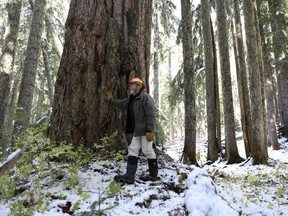Article content
BILLINGS, Mont. (AP) — The Biden administration on Tuesday abruptly dropped its nascent plan to protect old-growth forests after getting pushback from Republicans and the timber industry.

BILLINGS, Mont. (AP) — The Biden administration on Tuesday abruptly dropped its nascent plan to protect old-growth forests after getting pushback from Republicans and the timber industry.
Article content
Article content
The move was announced by U.S. Forest Service Chief Randy Moore in a letter to forest supervisors.
It brings a sudden end to a yearslong process to craft a nationwide plan that would better protect old trees that are increasingly threatened by climate change. The effort had been supported by some conservationists as one of the most significant forest preservation efforts in decades.
Advertisement 2
Story continues below
Article content
President Joe Biden launched the initiative with an executive order on Earth Day in April 2022. The proposal went through extensive public comment periods and internal analyses by government officials and was due to be finalized any day.
The plan would have limited logging in old-growth forests, with exceptions to allow logging in some old-growth areas to protect against wildfires.
But those exceptions were not enough for the timber industry and Republicans in Congress who bitterly opposed the administration’s proposal. They said it wasn’t needed since many forested areas already are protected. And they warned it could be devastating to logging companies that rely on access to cheap timber on public lands.
GOP lawmakers introduced legislation while the administration’s plans were still in the works to block them from going into effect.
Moore said in his letter that much was learned from the first-of-its-kind effort to identify old-growth trees on public lands across the nation. But he also acknowledged criticism from those who said the administration’s approach to old-growth forests was flawed since they can vary greatly between different types of ecosystems.
Article content
Advertisement 3
Story continues below
Article content
“There is strong support for, and an expectation of us, to continue to conserve these forests based on the best available scientific information,” Moore wrote. “There was also feedback that there are important place-based differences that we will need to understand in order to conserve old-growth forests.”
Old-growth forests, such as the storied giant sequoias of California, have layer upon layer of undisturbed trees and vegetation.
Most old-growth stands fell to logging as the nation developed. Yet pockets of ancient trees remain, scattered across the U.S. including in California, the Pacific Northwest and areas of the Rocky Mountains. Larger expanses of old growth survive in Alaska, such as within the Tongass National Forest.
There’s wide consensus on the importance of preserving them _ both symbolically as marvels of nature, and more practically because their trunks and branches store large amounts of carbon that can be released when forests burn, adding to climate change.
Wildfires in recent years decimated blocks of old-growth forest in states throughout the U.S. West and killed thousands of giant sequoias.
Advertisement 4
Story continues below
Article content
Wildfires, insects and disease have been the main killers of old-growth trees since 2000, accounting for almost 1,400 square miles (3,600 square kilometers) of losses, according to government research. Logging on federal lands cut down about 14 square miles (36 square kilometers) of old-growth forest — and timber industry representatives have said that figure shows further restrictions aren’t needed.
The Biden administration conservation plan faced a doubtful future if it had been finalized. During the first term of President-elect Donald Trump, federal officials sought to open up huge areas of West Coast forests to potential logging.
Federal wildlife officials under Biden reversed the move in 2021. They found that political appointees under Trump relied on faulty science to justify drastically shrinking areas of protected forest considered crucial habitats for the imperiled northern spotted owl. The owl has been in decline for decades as old-growth forests were cut in Oregon, Washington and California.
Article content
Comments